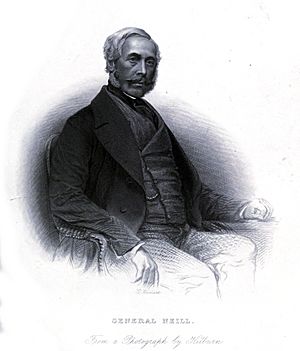James George Smith Neill facts for kids
Quick facts for kids
James George Smith Neill
|
|
|---|---|
 |
|
| Born | 27 May 1810 Swindridgemuir, Scotland, United Kingdom |
| Died | 25 September 1857 (aged 47) Lucknow, British India |
| Allegiance | |
| Service/ |
Madras Army |
| Years of service | 1827–1857 |
| Rank | Brigadier-General |
| Battles/wars | Second Burmese War Crimean War Indian Rebellion of 1857 |
James George Smith Neill (born May 27, 1810 – died September 25, 1857) was a British army officer. He worked for the East India Company and was involved in the Indian rebellion of 1857.
Contents
Early Life and Military Career
James Neill was born in Swindridgemuir, Scotland. His father was a Colonel. James went to the University of Glasgow. In 1827, he joined the British East India Company. A year later, he became a Lieutenant.
From 1828 to 1852, Neill mostly worked with his regiment, the 1st Madras Europeans. He also gained experience in other army roles. In 1850, he became a Major.
Serving in Burma and Crimea
In 1852, Neill went to the Second Burmese War with his regiment. He served well during the war. He became second-in-command and was promoted to Lieutenant-Colonel.
In 1854, he was chosen to help organize soldiers for the Crimean War. He worked with Sir Robert Vivian to prepare a Turkish group of fighters.
Role in the Indian Rebellion of 1857
Neill returned to India in early 1857. Soon after, news arrived that a big rebellion had started across northern India. This event is known as the Indian rebellion of 1857.
Neill acted quickly. He left Madras with his regiment and went to Benares. When he arrived on June 3, he decided to disband a local regiment of Indian soldiers. Some Sikh soldiers in Varanasi, who were usually considered loyal, also rebelled. They later returned to duty.
March to Allahabad
On June 9, Neill headed for Allahabad. A small group of Europeans were still holding out in the fort there against the rebels. Neill was very strict in his response to the rebellion. He ordered the hanging of people suspected of being rebels. His troops also carried out harsh actions against non-combatants. This caused some of his own Sikh forces to rebel.
Despite the heat and fighting, Neill's men reached Allahabad between June 6 and 15. Allahabad then became a gathering point for another British force led by Henry Havelock.
Actions in Cawnpore
Neill then moved towards the city of Cawnpore (now Kanpur). There had been a terrible event in Cawnpore where many European civilians were killed. In response, Neill and his troops carried out very harsh actions. He personally executed many prisoners. In one instance, he forced some local people to clean up the site of the massacre. They were then executed.
Meanwhile, Havelock's forces had to retreat because they didn't have enough men. Neill criticized Havelock's decisions. A second attempt to advance also failed. Neill's own communication lines were then attacked. However, Neill's efforts and Havelock's victory at Bithor helped secure the area.
Havelock's men returned to Cawnpore. A disease outbreak happened there. Neill again criticized his superiors, including the commander-in-chief.
Final Advance and Death
Despite his criticisms, Havelock gave Neill a command in the final push towards Lucknow. The march from Cawnpore to Lucknow began on September 18. There was heavy fighting on September 21. On September 22, it rained a lot. On September 23, it was very hot.
On September 23, the fighting for Lucknow began. Neill led his brigade at the front, putting himself in danger. He was heavily involved in fighting again on September 24. On September 25, he led the attack on Lucknow itself. As his men entered the city, Neill was suddenly shot in the head and killed in action at Khas Bazaar.
Memorials and Legacy
After his death, Neill's widow was given the same rank as the wife of a high-ranking knight. Memorials were built for him in Lucknow and in Ayr, Scotland. The memorial at the Residency in Lucknow lists Neill and many other soldiers who died during the rebellion.
A military area in Lucknow was named "Neill Lines" after him. Today, it is known as Neil Lines. An island in the Andaman Islands was also named after him, called Neil Island (now Neil Island).
See also
- Neil Statue Satyagraha

